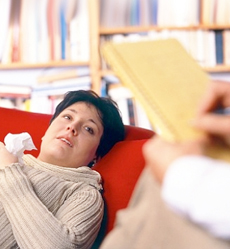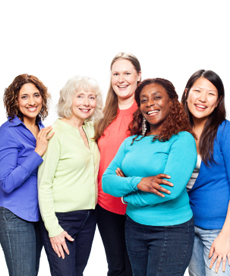|
|
Cognitive Behavioral Therapy : an Effective Treatment for Hot Flashes
 Hot
flashes (also known as
hot flushes, or night sweats) are a symptom of the changing hormone levels
that are considered to be characteristic of
menopause. The sensation of heat usually begins in the face or chest,
although it may appear elsewhere such as the back of the neck, and it can spread
throughout the whole body. Some women pass out if the effects are strong enough.
In addition to being an internal sensation, the surface of the
skin, especially on the
face, becomes hot to the touch. Hot
flashes (also known as
hot flushes, or night sweats) are a symptom of the changing hormone levels
that are considered to be characteristic of
menopause. The sensation of heat usually begins in the face or chest,
although it may appear elsewhere such as the back of the neck, and it can spread
throughout the whole body. Some women pass out if the effects are strong enough.
In addition to being an internal sensation, the surface of the
skin, especially on the
face, becomes hot to the touch.
The hot-flash event may be repeated a few times each week or constantly
throughout the day, with the frequency reducing over time. Hot flashes may begin
to appear several years before menopause starts and last for years afterwards.
Some women undergoing
menopause never have hot flashes. Others have mild or infrequent flashes.
In a new
British study, women who received psychotherapy, known as cognitive
behavioral therapy, had reduced symptoms of hot flashes, almost by half
within six months.
According to a study "These results suggest that cognitive behavioral therapy
delivered in group or self-help format is an effective treatment option for
women during the menopause transition and postmenopause with problematic hot
flashes/night sweats," wrote senior researcher Myra Hunter, at King's College
London.
Hunter's team randomly assigned 96 women who had been treated for
breast cancer and suffered from night sweats and hot flashes to either "talk
therapy" or usual care.
The 47 women who received the therapy attended weekly 90-minute sessions for
six weeks. For the others, usual care consisted of access to nurses and
oncologists, telephone support and cancer support services, the researchers
noted.
The therapy sessions included psycho-education, paced breathing, and
behavioral strategies to manage hot flashes and night sweats, as well as
interactive PowerPoint presentations, group discussion, handouts and weekly
homework, Hunter said.
In addition, participants learned how to handle the
stress associated with hot flashes and night sweats, and found new ways to
decrease anxiety, she explained.
The women were also taught to manage hot flashes in social situations and to
understand night sweats and improve sleep habits using mental and behavioral
strategies.
The investigators found that the women who had received the cognitive
behavioral therapy significantly reduced the number of hot flashes and night
sweats they experienced in the nine weeks after the start of the study.
This reduction in symptoms lasted for 26 weeks. At nine weeks there was a 46
percent reduction in symptoms and a 52 percent reduction at 26 weeks, Hunter's
team found.
 Psycho-education: an education with a goal for the patient to
understand and be better able to deal with the presented illness. Psycho-education: an education with a goal for the patient to
understand and be better able to deal with the presented illness.
Through an improved view of the causes and the effects of the illness,
psycho-education helps in broadening the patient's view of illness and this
increased understanding can positively affect the patient. Important elements in
psychoeducation are:
-
Information transfer (symptomatology of the disturbance, causes,
treatment concepts, etc.)
-
Emotional discharge (understanding to promote, exchange of experiences
with others concerning, contacts, etc.)
-
Support of a medication or psychotherapeutic treatment, as cooperation
is promoted between the mental health professional and patient (compliance,
adherence).
-
Assistance to self-help (e.g. training, as crisis situations are
promptly recognized and what steps should be taken to be able to help the
patient).
Paced Breathing: Rhythmic, paced
breathing balances the autonomic nervous system, and is an effective
therapeutic treatment for hot flashes. Apart from the prolonged training,
practicing, skill, and motivation needed, effortlessly performed paced breathing
involves individualized breathing patterns that typically require personal
coaching. The physiological origin of the hypotensive effects of paced breathing
has traditionally been attributed to the �relaxation response.�
Relaxation is a widely accepted, beneficial outcome of slow breathing.
Rhythm formulas that involve breathing at six breaths per minute induce
favourable psychological and possibly physiological
effects.
Principles of device-guided paced breathing: (1) monitoring breathing movements,
(2) composing breathing-guiding tones, and (3) synchronizing breathing movements
with the guiding tones.
Behavioral Strategies: Behavior is defined any action that can be
seen or heard. An effective method of examining behavior is to use the ABC
model:
A=Antecedent: The event occurring before a behavior. This event prompts that
behavior.
B=Behavior: Response to the events that can be seen or heard.
C=Consequence: The event(s) that follow(s) the behavior. This effects whether
the behavior will occur again.
By making an effective use of this strategy symptoms of hot flashes can be
considerably controlled.
By making use of these therapeutic strategies women are
bound to feel more confident about coping with menopausal
symptoms, like hot flashes.
Dated 31 March 2012
Related Links
|
|
|
|
|









